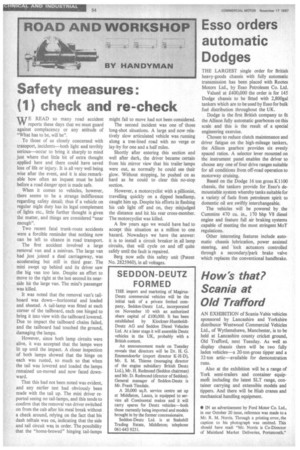Safety measures: (1) check and re-check
Page 56

If you've noticed an error in this article please click here to report it so we can fix it.
WE READ so many road accident reports these days that we must guard against complacency or any attitude of "What has to be, will be".
To those of us closely concerned with transport, incidents—both light and terribly serious—occur to bring it sharply to mind just where that little bit of extra thought applied here and there could have saved loss of life or injury. It is all very well being wise after the event, and it is also remarkable how often an inquest must be held before a road danger spot is made safe.
When it comes to vehicles, however, there seems to be a strange indifference regarding safety detail; thus if a vehicle on regular night duty has its legal complement of lights etc., little further thought is given the matter, and things are considered "near enough".
Two recent fatal trunk-route accidents were a forcible reminder that nothing now can be left to chance in road transport.
The first accident involved a large removal van and a minivan. The large van had just joined a dual carriageway, was accelerating but still in third gear. The mini swept up behind and its driver saw the big van too late. Despite an effort to move to the right at the last second its nearside hit the large van. The mini's passenger was killed.
It was noted that the removal van's tailboard was down—horizontal and loaded and sheeted. A tail-lamp was fitted at each corner of the tailboard, each one hinged to bring it into view with the tailboard lowered. Due to impact the tailboard chains failed, and the tailboard had touched the ground, damaging the lamps.
However, since both lamp circuits were alive, it was accepted that the lamps were lit up until the impact. A closer inspection of both lamps showed that the hinge on each was rusted, so much so that when the tail was lowered and loaded the lamps remained un-moved and now faced downward.
That this had not been noted was evident, and any earlier test had obviously been made with the tail up. The mini driver reported seeing no tail-lamps, and this tends to confirm that the removal van driver switched on from the cab after his meal break without a check around, relying on the fact that his dash telltale was on, indicating that the side and tail circuit was in order. The possibility that the "home-brewed" hinging tail-lamps might fail to move had not been considered.
The second incident was one of those long-shot situations. A large and now relatively slow articulated vehicle was running along a tree-lined road with no verge or lay-by for one and a half miles.
Shortly after entering this section and well after dark, the driver became certain from his mirror view that his trailer lamps were out, as normally he could see their glow. Without stopping, he pushed on as hard as he could to clear this no-stop section.
However, a motorcyclist with a pillionist, travelling quickly on a dipped headlamp, caught him up. Despite his efforts in flashing his cab light off and on, they misjudged the distance and hit his rear cross-member. The motorcyclist was killed.
A few years ago we would have had to accept this situation as a million to one hazard. Nowadays we have the answer: it is to install a circuit breaker in all lamp circuits, that will cycle on and off quite safely until the fault is repaired.
Berg now sells this safety unit (Patent No. 2825960), in all voltages.
















































































































































